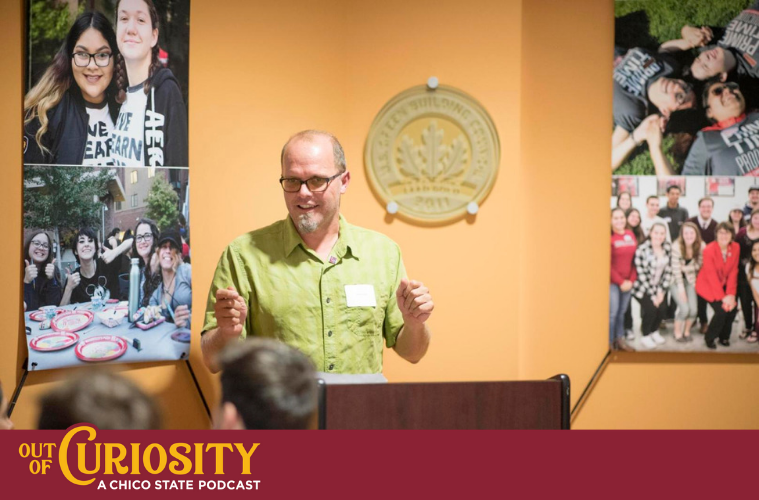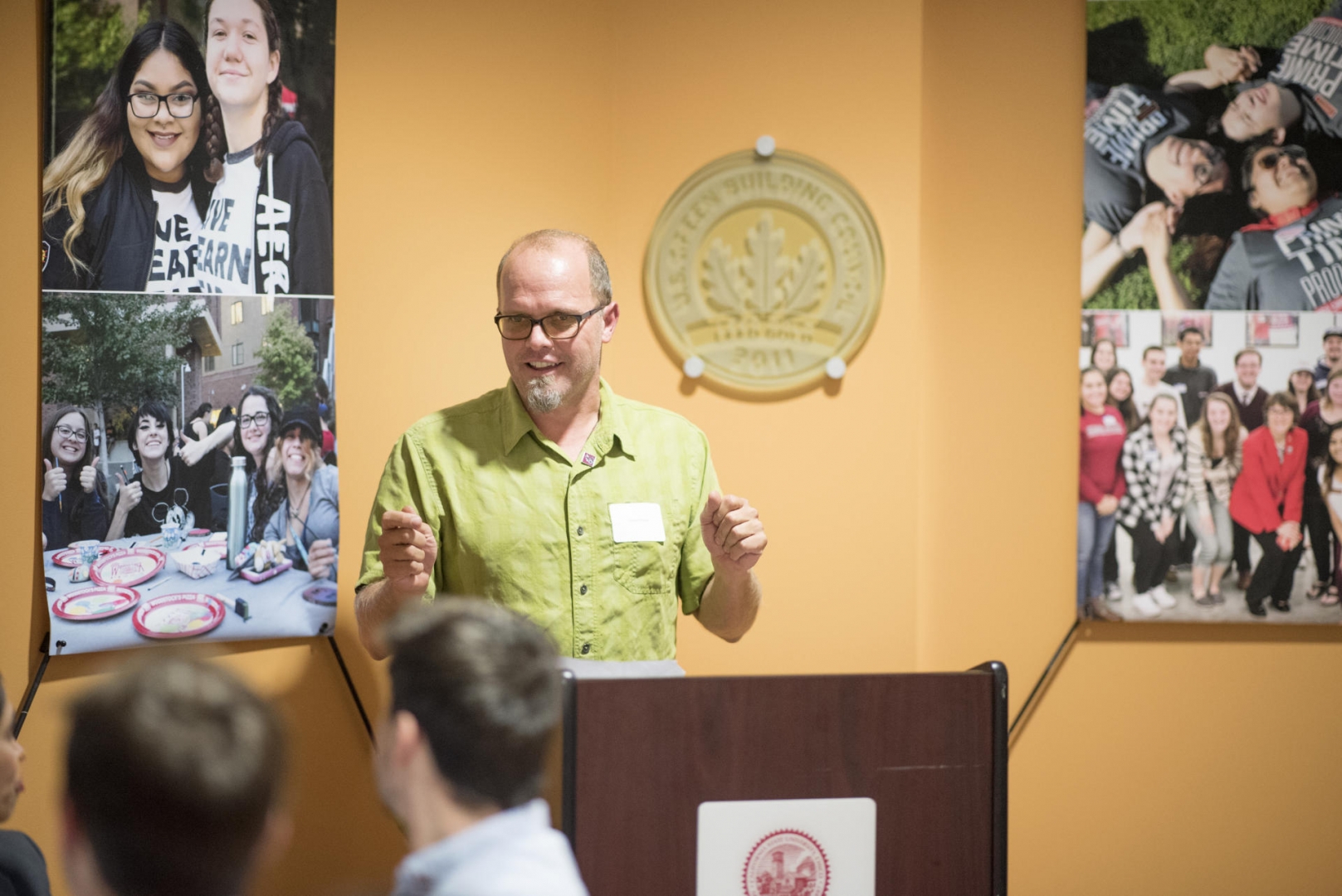What Can We Learn From the Dirt?

Dirt is all around us—literally, in Earth’s case. Maybe we don’t give it its proper due, though: Civilizations have crashed because of misunderstandings about soil’s importance.
Chico State professor Garrett Liles explains why soil is such a vital part of our world.
Listen
Subscribe on Apple Podcasts, Spotify, or wherever you listen to podcasts.

Read the Transcript
(SOUNDBITE OF MUSIC)
KATE POST, HOST: This is Out of Curiosity, a podcast driven by the wonder of lifelong learning from California State University, Chico.
TRAVIS SOUDERS, HOST: Welcome to Out of Curiosity. I’m Travis Souders.
POST: And I’m Kate Post.
SOUDERS: Have you ever noticed that we call it dirt when we bury dead things in it, but we call it soil when we plant things in it?
POST: And they’re kinda the same thing, right? So, we got to thinking, and on today’s show, we wanted to talk about what you can learn from the dirt!
SOUDERS: Our guest today is Garrett Liles, a professor in Chico State’s college of agriculture. Professor Liles teaches plant and soil science, and he works with the campus’ Center for Regenerative Agriculture and Resilient Systems.
POST: So if there’s anyone who knows about dirt, it’s Professor Liles.
SOUDERS: Almost all of us encounter dirt or soil every single day without ever giving it a second thought, but maybe we should! Soil is really important.
POST: The history of human civilizations has always been changed and shaped by the soil available to the people around them.
PROFESSOR GARRETT LILES: Soils and civilization are really equivalent, because without soil, the sedentary lifestyle of agriculture, and the productivity that’s allowed us to move from hunting and gathering into a civilization that allowed for differentiation of arts and cultures and religion; without soil none of that would have been possible because that’s what produces the food and fuel and fiber we rely on.
SOUDERS: So, what we’ve learned from history is that our failure to actually pay attention to the soil around us and what it’s doing for our civilizations, has actually led to that civilization crumbling.
LILES: As civilizations have come and gone, starting with the kind of origin of Western civilization in the Fertile Crescent, that is a place now that was a fertile alluvial flood plain where agriculture sprung up. Where’s that place now? It’s a desert where we’ve been fighting wars for multiple years, and it’s dry, and it’s not something that would convey the fertility that promoted civilization. That cycle has occurred again and again, with soils being utilized and mis-utilized, leading to civilizations crashing. It happened in the Mediterranean, it’s happened again and again, and the only thing that’s really stopped it has been the evolution of thought and conservation and things like that.
POST: The wake-up call to this in the modern era was the Dust Bowl, in the 20th century, when farmland began to dry up in the Midwest because of poor soil management practices.
LILES: And that really got people to sit up and realize it was a finite thing; it wasn’t infinite, and that losing soil through erosion and other poor practices really wasn’t the way to go. And we’re really at that point again, as a society, if you look around and you pay attention to any kind of media. Soils are really a popular subject right now, related to climate change and the ability for soils to store large volumes of carbon that’s now in the atmosphere as carbon dioxide, and storing that in a little bit more longer-term reservoir in soil. So, post-Dust Bowl was really the period in North America, particularly, soil became something that people studied and thought about.
SOUDERS: So, what we learned about the soil was that not only did it help support every other system that we found to be important—like farming, agriculture in general—but the soil itself was a vital, critical component to survival on Earth, period.
LILES: You’re hard-pressed to think of something on our planet, outside of deep geologic things, that isn’t directly related to soil in one way or another. So soils really integrate all the main cycles of the planet. Even deep ocean sediments and rocks that form in the ocean come from products of erosion and weathering that come off land surfaces.
POST: So, what Professor Liles seems to be saying is that soil is not just a helper.
SOUDERS: Right! What he’s saying is that soil is everything—food, and water, and the atmosphere and the air. All systems on Earth are affected by the soil.
LILES: Is soil alive, or is soil a container for life? I ask my students that question very directly because I want them to not just think of it as a container, because that’s one of the things that’s led us to the point we’re at right now, with our agricultural practices and a general lack of concern. I fall very, very clearly on the side of the fence that just says soils are alive and they’re a living, breathing being.
SOUDERS: On top of soil telling us what an area is like now, it’s also a little bit of a history lesson about what the area was like millions of years before.
LILES: People use soils regularly to understand past climates, so the minerals and a lot of the features that can form in the soil might tell you what happened 50, 60, 100,000, 5 million years ago, depending on where that soil is and if it’s in a stable location.
POST: It turns out, the soil can also tell us what humans were like thousands of years ago, and how our civilizations rose and fell.
LILES: Probably the most important thing that links people to soil is color, right? So, back to the story of early agriculture and civilization, once folks figured out that dark, organic, rich soils on flood plains were going to lead to the most success in their agricultural endeavors as they were digging with sticks and collecting seeds and starting to do some basic plant breeding, that became the signal: Dark soils meant productive.
POST: One thing that I’ve gleaned from this conversation is how interdisciplinary soil science is.
LILES: Very much so, yeah.
POST: It’s a little bit of geology, you’ve got some biology, some chemistry, um, you know—
LILES: Physics.
POST: —Ecology, physics, all of that.
LILES: Economics, right?
POST: And this is the part that’s new to me, the confluence of sociology, economics, history.
LILES: Yeah.
SOUDERS: Our anthropology folks would be interested, our agriculture folks—
LILES: Art, yeah. You know, the chemists claim chemistry is the central science. They claim that, but soil is the central ecosystem science or physical science, because it does, you have to know a little of those things—and this is where I’m trying to pitch this idea to students—it’s something that allows you to dive into some area in-depth, but always come out and have some pertinence or some application if you’re talking about what is that effect on soil, and how does that affect humanity?
SOUDERS: For anybody listening to this anywhere, no matter where in the world, let alone the country or the area, if you’re looking at the dirt underneath your feet, what’s a way you can look at it, or touch it, or interact with it and pull some kind of story from it?
LILES: Look out the window while you drive, and look at the road cuts, because you see a ton, just even at 60 mph, you can see one’s red, one’s not, that one’s different, there’s rocks in that one. There’s a lot. You can become very observant very quickly, even if you don’t know any reason why they’re different, you can start to appreciate how different they are, even just flying by.
POST: Another great way to visualize the differences in the soils is just by looking around at what grows in it.
LILES: The vegetation that’s growing above ground can tell you a lot about soils. If you were so fortunate to ride your bike from Chico State’s campus to Upper Bidwell Park, you would notice that the vegetation changes. Not drastically across every mile that you rode, but there are certain places on the landscape where things change drastically. And often those changes in vegetation really do give you an indication of soil depth, soil productivity, and some of these other features. You can pick up a lot about where soils are similar or where they’re different, just by looking at natural vegetation.
SOUDERS: Whether you’re noticing the red dirt of Northern California, or you’re working in your planter box and notice how rich the soil that you’re working in is, take a moment to appreciate just how important soil actually is to our world.
POST: And how much it’s influenced human civilization.
LILES: Certain people are those that believe dirt is a true four-letter word that implies something that’s foul, and that soil is the only way to go, you can only call it soil. And what I tell people is that as long as you understand that it’s the most important thing on the earth, then I don’t care what you call it.
POST: Special thanks to our guest today, Professor Garrett Liles. This has been Out of Curiosity. I’m Kate Post.
SOUDERS: And I’m Travis Souders. The show is produced by the Office of University Communications at California State University, Chico. Make sure you never miss an episode by subscribing wherever you listen to podcasts.
(SOUNDBITE OF MUSIC)


